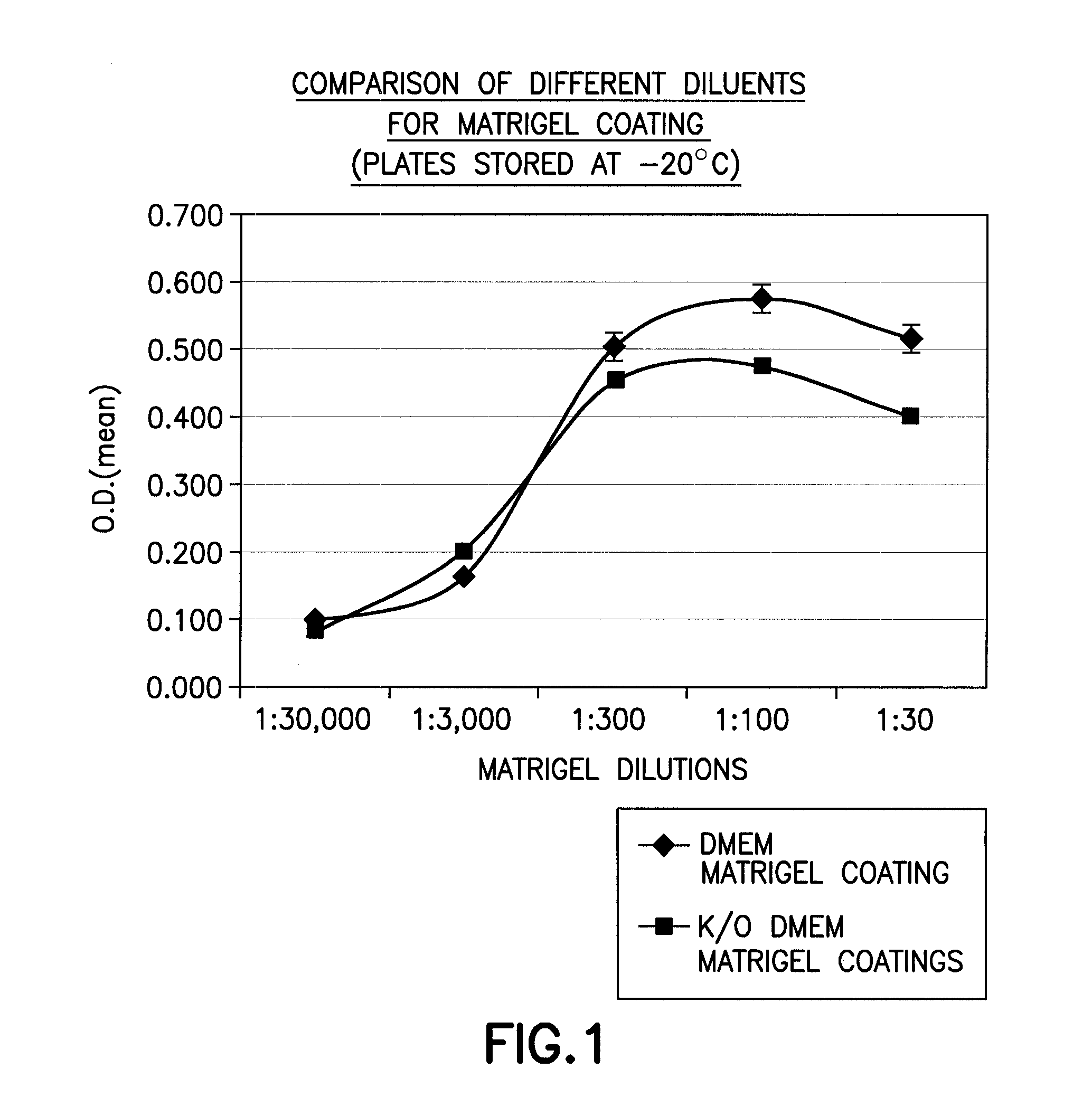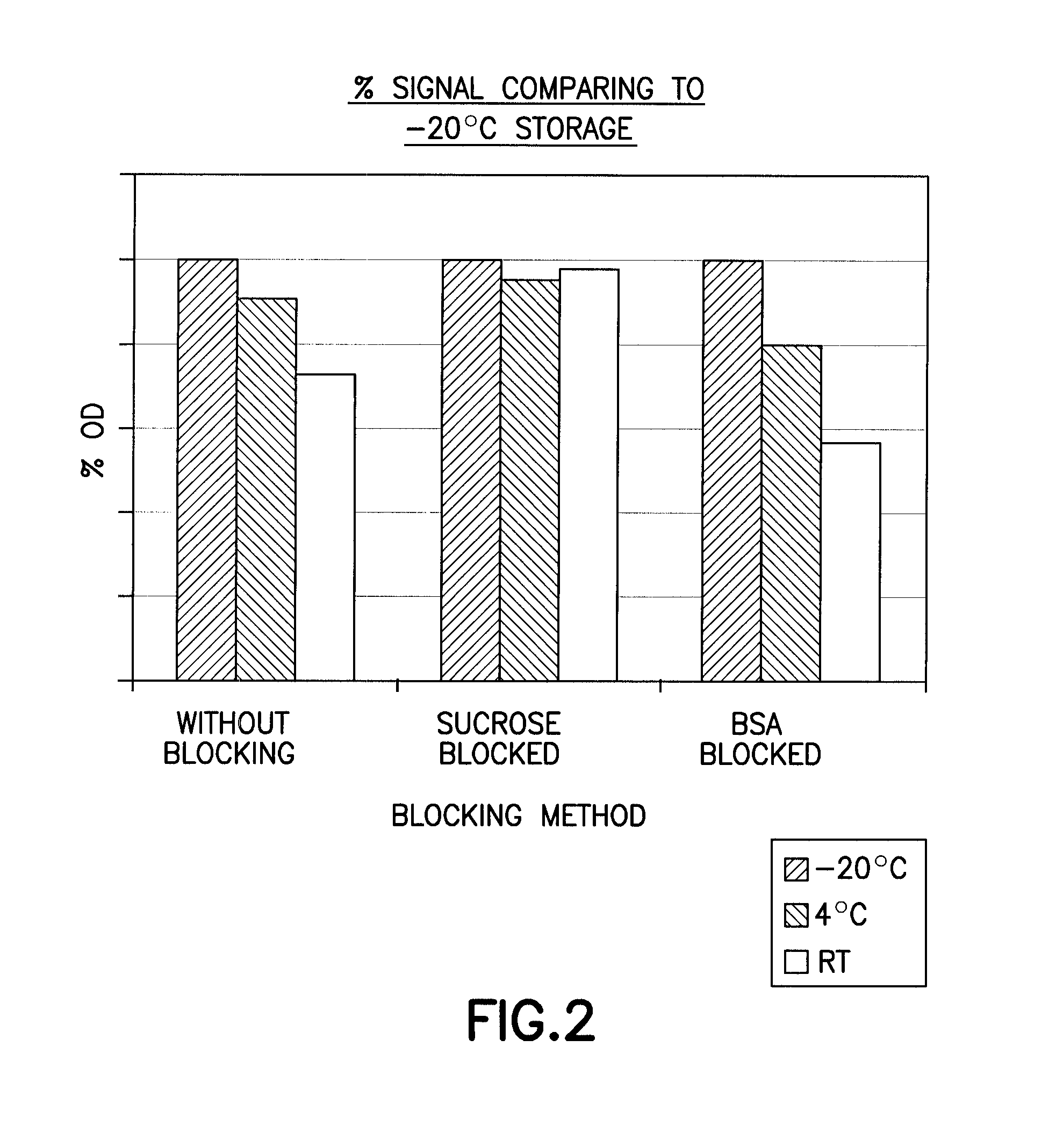Extracellular matrix coated surface for culturing cells
a technology of extracellular matrix and culturing cells, which is applied in the field of cell culturing, can solve the problem of unbound protein being washed off the surface, and achieve the effect of reducing the number of culturing cells
- Summary
- Abstract
- Description
- Claims
- Application Information
AI Technical Summary
Benefits of technology
Problems solved by technology
Method used
Image
Examples
example 1
Optimization of ECM-Coated Surfaces
[0112]In an effort to prepare stable, ready-to-use ECM-coated substrates, BD Matrigel™ Matrix (Cat. No. 354234; Becton, Dickinson & Co.) was first thawed overnight at 4° C. on ice. A series of dilutions of Matrigel™ (10 mg / ml stock) was then prepared (e.g., 1:30, 1:100, 1:300, 1:3000, 1:30,000) using cold (4° C.) DMEM (Cat. No. 10313-021; Invitrogen) or K / O-DMEM (Cat. No. 10829-018; Invitrogen). Aliquots (2 mls / well) of each of the five diluted Matrigel solutions and a control solution were added to the wells of a 6-well plate (Cat. No. 353046; Becton, Dickinson & Co.), swirled gently to coat the entire bottom surface of the well, and incubated at room temperature for about two hours. Each 6-well plate included at least one control well, which received the control solution. The control solution was media with no Matrigel™.
[0113]After incubation, the Matrigel™ dilutions and the control solution were removed from the wells vial aspiration, and 6 mls ...
example 2
Determination of Amount of Absorbed Protein on Coated Plates
[0118]The present example is directed to the detection and quantitation of extracellular matrix protein adsorbed to the coated surface using an ELISA assay. The ELISA assay was designed to detect collagen IV in the plate coating, using an anti-mouse collagen IV antibody. Collagen IV is a major ECM component. Detection of other proteins in the plate coating is also possible and well within the ability of the skilled artisan through the use of antibodies specific for other proteins in the coating composition.
[0119]Plates coated as described in Example 1 (100 μg / mL) and uncoated control plates were allowed to equilibrate to room temperature, Coated plates were washed by adding 2 mL wash buffer (0.2 mL Tween-20 (Sigma-Aldrich, St. Louis, Mo., Product #1379) in 1 L of 1×PBS (without calcium and magnesium ions)) to each well, removing the wash buffer and blotting each plate on paper towels to remove excess liquid on the sides of ...
example 3
Preparation of Fibroblast (MEF) Feeder Layers
[0124]The present example is directed to the procedure used to prepare MEF feeder layers from which MEF-conditioned medium was harvested. Moreover, MEF feeder layers were used as a control surface for culturing human embryonic stem cells according to methods well known in the art.
Preparation of Substratum for Feeder Cells
[0125]Inactivated MEF feeder cells (irradiated or mitomycin-C treated CF-1 line from ATCC, Manassas, Va.) are seeded on gelatinized cell culture dishes in order to provide better support for long culture periods. In particulars culture dishes are coated with a 0.1% gelatin solution, followed by incubation for about 1 hour to overnight at room temperature. Thereafter, the gelatin was removed, and the gelatin-coated dishes were rinsed with calcium, magnesium free Phosphate Buffered Saline (PBS) just prior to plating the inactivated feeder cells thereon.
Thawing and Culturing of the Feeder Cells
[0126]A vial of cells (irradiat...
PUM
| Property | Measurement | Unit |
|---|---|---|
| concentration | aaaaa | aaaaa |
| temperature | aaaaa | aaaaa |
| concentration | aaaaa | aaaaa |
Abstract
Description
Claims
Application Information
 Login to View More
Login to View More - R&D
- Intellectual Property
- Life Sciences
- Materials
- Tech Scout
- Unparalleled Data Quality
- Higher Quality Content
- 60% Fewer Hallucinations
Browse by: Latest US Patents, China's latest patents, Technical Efficacy Thesaurus, Application Domain, Technology Topic, Popular Technical Reports.
© 2025 PatSnap. All rights reserved.Legal|Privacy policy|Modern Slavery Act Transparency Statement|Sitemap|About US| Contact US: help@patsnap.com


